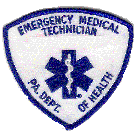

There are two different bodies governing over the Emergency Medical System in Pennsylvania. They are "The Department of Health" and "EMS Councils."
On the state level, "The Department Of Health" develops statewide guidelines such as which drugs may be used and what equipment is required on an ambulance.
On a local level, the state is divided into 16 regions called "EMS Councils". Some regions consist of several counties. Other regions, like southeastern PA, consist of only one county in size due to the higher population and number of providers within that geographical region. The regions are responsible for local guidelines such as developing treatment protocols (that are within what the state allows to be performed) and response districts for each ambulance service.
The Pennsylvania EMS is governed by what is known as the "Emergency Medical Services Act" ("Act 45"). "Act 45" is a set of guidelines put into law by the State government. "Act 45" outlines such policies as response times, required equipment on ambulances, and skills allowed by certain levels of provider certification.
On July 1, 1996, a new law known as "Act 82" took effect statewide. Emergency care providers in Pennsylvania, (First Responder, EMT-basic-intermediate and EMT-Paramedic) became permanently certified. Providers were originally only given the option to re-certify by challenging the exam or taking refresher courses every three years. "Act 82" ensures that certification, as a provider, is good for life as long as certain continuing educational requirements are met. First Responders and EMT's (basic and intermediate) need to maintain 24 credits of continuing-education hours over 3-year incremental periods. Paramedics are required to earn 18 credits annually.
Levels of Certification
"First Responder "
First Responders fall somewhere between Advanced First Aid and an EMT-Basic. The First Responder class, which is a minimum of 41 hours, teaches advanced First Aid techniques, in addition to some basic oxygen therapy and airway adjuncts. First Responders also learn about cervical/spinal immobilization as well as AED skills (Automatic External Defibrillation).
"Emergency Medical Technician - Basic"
EMT's in Pennsylvania go through a minimum of 130 hours of training, which includes classroom lecture, practical sessions, and ER clinical time.
Topics of the EMT class include:
1. Treating life threatening emergencies.
2. Muscular skeletal injuries.
3. Common medical emergencies.
4. Childbirth and problems of pediatric patients.
5. Lifting and moving patients.
6. Environmental emergencies.
7. Extrication from automobiles.
8. The responsibilities and operations of an EMT's role in EMS.
Some specific skills that basic EMT's in PA can do include:
· MAST application/inflation
· Automatic External Defibrillation (AED)
· Naso/Oropharyngeal Airways
· Assist patients with self-administration of Nitroglycerine
· Assist patients with self-administration of Epinephrine
"Emergency Medical Technician - Paramedic"
Paramedics in Pennsylvania go through a minimum of 212 instructional and 232 clinical hours of training, which includes classroom lecture, practical sessions, ride-along instruction, and clinical sessions in places such as the hospital ER, operating room, IV team, etc.
Some skills that paramedics in PA can do include:
1. Drug and fluid Therapy by the following routes:
· Intravenous - into veins
· Intra-osseous - bone
· Sublingual - under the tongue, underside of tongue
· Intra-muscular - muscle
· Subcutaneous - under the skin
· Oral - by mouth
· Aerosol - inhalants2. Cardiac Defibrillation/Pacing/Cardioversion
3. Nasal/Oral Intubation
4. Needle Chest Decompression
5. Transtracheal Jet Insufflation
6. Needle Cricothyrotomy
7. Carotic Massage Therapy
8. Direct Laryngoscopy
These are some of the drugs permitted for pre-hospital use in the state of Pennsylvania:
1. Adenosine
2. Albuterol
3. Aminophylline
4. Aspirin
5. Atropine Sulfate
6. Bretylium
7. Calcium Chloride
8. Dexamethasone Sodium Phosphate
9. Diazepam
10. Diphenhydramine HCl
11. Dobutamine
12. Dopamine
13. Epinephrine HCl
14. Furosemide
15. Glucagon
16. Heparin IV
17. Heparin Lock Flush
18. Hydrocortisone Sodium Succinate
19. IV Electrolyte Solutions including Dextrose, Lactated Ringers NaCl, and Normosol
20. Isoproterenol HCl
21. Lidocaine HCl
22. Magnesium Sulfate
23. Meperidine
24. Metaproterenol
25. Morphine Sulfate
26. Naloxone HCl
27. Nitroglycerine IV
28. Nitroglycerine Ointment
29. Nitroglycerine Spray
30. Nitroglycerine SL Tablets
31. Nitrous Oxide
32. Oxytocin
33. Procainamide
34. Sodium Bicarbonate
35. Sterile Water for Injection
36. Terbutaline
37. Verapamil
"Pre-hospital Registered Nurse- PHRN "
A PHRN in the state of Pennsylvania is equivalent to a Paramedic when in comes to what theycan and cannot do in the pre-hospital setting. In some instances, a PHRN can run IV pumps andother equipment as well as administer other medications that a paramedic normally cannot do without additional training. The distinct difference is that a PHRN is a Registered Nurse. RN's do not generally need to go through the entire Paramedic course.
Back